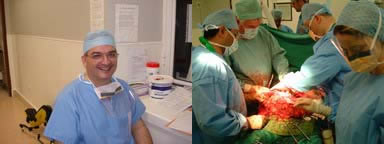 |
 |
|
|
All images, illustrations & flash animation are copyrighted to Deya Marzouk, unless stated otherwise. Copy is prohibited without written permission. Innovative techniques mentioned in this web site were all devised by Deya Marzouk. Please Credit Deya Marzouk if any material is copied from here (with prior permission only) |
Continence is a very complex physiological process, that depends on more than the integrity of the anal sphincters muscles and its nerve supply. Other factors such as sensation and stool consistency play a strong part as well. The various factors are summarized in the flash slide show below.
Needless to say, normal continence depends on the interplay of these factors. Continence often fails if one of the important factors (such as the sphincter muscles) is severely affected or more often when there is affection of several of these factors together.
It is not uncommon, but often unreported by patients because of embarrassment. Estimates vary, but it is possible that it may affect 1% of the population (up to 10% of the elderly & 20-30% of residents of nursing homes).
| 1. Congenital Anomalies | Anorectal malformations Myelomeningocoele & Spina bifida |
| 2. Trauma | Surgical trauma to sphincters: fistulotomy, fistulectomy, haemorrhoidectomy, sphincterotomy and sphincter stretch (anal dilatation). Surgery for Hirschsprung’s disease & anorectal malformation Obstetric trauma: 2nd & 3rd degree tears. Unrecognized tears Accidental trauma: pelvic fractures, Impalement injuries and war (blast) injuries Sexual assault: Anal rape |
| 3. Local Pathology and / or loss of Reservoir | Faecal impaction & overflow incontinence Rectal prolapse Rectocoele (usually with weak sphincters) Rectal cancer (invading sphincters) Carpet villous adenoma of the rectum (leak of mucus) Rectovaginal fistula Severe proctitis secondary to IBD, especially crohn’s disease Radiation proctitis Ischaemic proctitis Rectal stricture Ultralow anterior resection, coloanal anastomoses & IPAA |
| 4. Neurological | Cerebral causes: Cerebral tumours or trauma, vascular accidents, dementia, multiple sclerosis, Tabes dorsalis, arachnoiditis Spinal causes: Spinal tumours or trauma, cauda equina lesions, central prolapsed disc, meningomyelocoele Peripheral neuropathy: sacral nerves invasion by pelvic cancer Autonomic neuropathy: Diabetes Pelvic floor neuropathy: Neurogenic (neuropathic or idiopathic) incontinence [pudendal neuropathy] |
| 5. Miscellaneous | Laxative abuse Severe diarrheal conditions: Massive bowel resection, IBD, IBS Encopresis Psychiatric conditions |
As can be seen there is a long list of causes of faecal incontinence. Among the more common causes seen in clinical practice are: obstetric sphincter injuries, surgical damage to sphincters during fistulotomy, severe road traffic accidents, impalement injuries, faecal impaction, rectal prolapse, rectocoele, proctitis, loss of reservoir capacity of the rectum after low rectal resections, Diabetes and pudendal neuropathy.
Many patients have more than one contributing cause (multi factorial incontinence), especially those with:
1) Obstetric trauma, when sphincter injury is sometimes accompanied by pudendal neuropathy. 2) Patients with pelvic floor problems, including rectal Prolapse & rectocoeles, where there is usually pudendal neuropathy, decreased sensations, disordered evacuation mechanics with poor evacuation and not uncommonly weak sphincters. 3) Elderly patients, who may have impaired sensations, pudendal neuropathy & weak sphincters, rectal prolapse, intermittent faecal impaction & finally Diabetes.
Faecal incontinence on occasions may be present despite normal sphincters & pelvic floor in cases of:
1) Severe diarrhoea (Infective diarrhoea, Inflammatory bowel disease, Diabetic autonomic neuropathy, After massive intestinal resection). 2) Faecal impaction. 3) Encopresis. 4) Rectovaginal Fistula. 5) some patients who had ultralow anterior resections, coloanal Anastomoses & Ileal pouch anal anastomosis construction.
Assessment of patients of faecal incontinence needs time & experience. Some patients are too embarrassed or too distressed about incontinence, that they may not divulge their real concerns at the start of their consultation. Some will give prominence to other symptoms and try to downplay their concerns about incontinence. I would estimate that up to one quarter of patients I see may have been referred with a different symptom. Their real concerns start to crop up in the discussion minutes later. It is useful to inquire directly about faecal incontinence when seeing patients with colorectal symptoms.
It is important to explore patients past medical history including obstetric and surgical history (operations), history of obstructed defaecation over a long time (usually suggest pudendal neuropathy, with or without incomplete rectal evacuation secondary to rectal intussusception & rectocoele: see under Function: obstructed defaecation), diabetes, radiotherapy, IBD, use of medications, and associated genital prolapse or urinary incontinence. Examination of perineum, anus, rectum and vagina usually completes the picture.
The first task afterwards is to judge the magnitude of the problem (severity) as this will often determine the initial approach to treatment and whether anorectal physiology is required at this initial stage (often omitted in patients with mild or moderate symptoms, who are likely to respond well to conservative management. Secondly, an attempt is made to look for any obvious clinical clues to the aetiology (see under recognizable clinical scenarios in the table below). Thirdly, a decision is made about the appropriate initial treatment.
Anorectal physiology assessment is needed in a fair number of patients to understand all aspects of a particular patient's incontinence (see under Tests: Anorectal physiology). In an ideal world, all patients should have anorectal physiology testing, but in practice this is not needed in all.
I. Preliminary clinical assessment
II. Anorectal physiology assessment |
| Incontinence to Mucus Only | Prolapsed Haemorrhoids, Whitehead deformity, Mucosal rectal prolapse, Rectal prolapse, Villous adenoma |
| Urge incontinence | Proctitis & other causes of loss of rectal reservoir function (e.g. ultralow resections), partial sphincter defects & Pelvic floor neuropathy |
| Passive Incontinence | Elderly, Rectal prolapse, Neuropathic Faecal Incontinence, Internal sphincter defects, Sensory impairment (e.g. MS or Diabetes) |
| Soiling | May indicate that the anal canal is deformed from scarring, faecal impaction or megarectum. |
The severity of incontinence may be scored (to allow comparison before & after treatment). There are many scoring systems. I created one in 1989 and modified it in 1994 (below), but it seems that the most popular scoring system is the one devised by Wexner in 1996.
Wexner Continence Grading Scale (1996) |
Score |
|
0 |
|
0 |
|
0 |
|
0 |
|
0 |
Wexner Continence Score: |
0 - 20 |
Modified Marzouk Incontinence Score (1994) |
Score |
|
Incontinence Frequency
|
0 |
|
Incontinence Severity
|
|
|
Use of pads
|
0 |
|
Use of medications
|
0 |
|
Effect on social life
|
0 |
|
Marzouk Incontinence Score: |
0 - 13 |
Summary of treatment of Faecal Incontinence
|
1. Constipating drugs: These are the corner stone of conservative management, as many patients have frequent & loose bowels. Such drugs reduce urgency, the number of episodes of incontinence and may even render the patient continent (many patient would be able to remain continent to solid stools, but would be incontinent to loose motions). Any of the following may be used alone or in combination
a) Loperamide hydrochloride (Imodium). This is the main drug used. Patients and GPs are reluctant to use it in sufficient dosages. Some patients may need 12-24 tablets per day to control loose bowel motions
b) Codeine phosphate. Another very useful drug, but can make patients drowsy initially
c) Lomotil. Lomotil is an alternative which is especially useful in diarrhoea associated with colics (contains atropine).
B. Bulking agents Methylcellulose and Isogel can improve faecal consistency (well formed stools easy to pass but difficult to loose spontaneously
2. Dietary advice: Avoidance of spicy irritant foods, avoidance or reduction of dairy products, coffee and beer. This reduces urgency in many patients. Patients with loose motions also benefit from avoidance of excess vegetables & fruit or any foods noted to cause diarrhea.
3. Keeping the rectum empty (planned defaecation): The idea is simple; if the rectum is empty, there is no faeces to leak. Patients need to aim at complete evacuation of rectum in a predictable way. It sometimes helps to establish a workable time for defaecation, same time every day (if at all possible), say 20-30 m after a meal to take advantage of the gastrocolic reflex. More complete evacuation may be achieved by using glycerine suppositories, either to help initiate defaecation, but more commonly (in patients with faecal incontinence) to evacuate more. The latter means advising patients to use glycerine suppositories after defaecation, wait 20 minutes and to try to evacuate some more. This is particularly useful in patients with post defaecation leakage. Some patients are helped by regular use of disposable phosphate enemas once a day (some elderly with disordered defaecation & incontinence)
4. Physiotherapy (pelvic floor & perineal exercises) may also help
Conservative treatment is often needed alongside other options such as sphincter repair or SNS
 |
 |
|